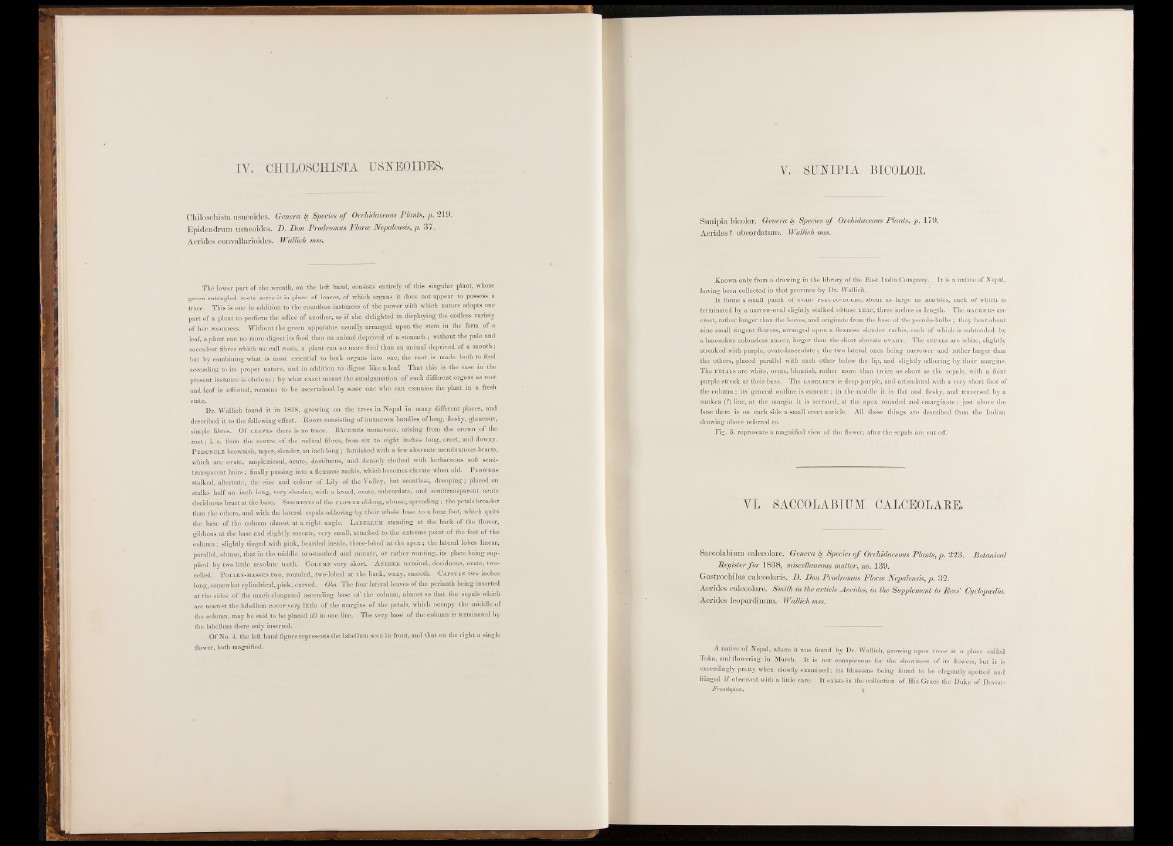
IV, CHILOSGEISTA USNEOIDES,
Chiloschista usneoides. Genera § Species of Orchidaceous Plants, p. 219.
Epidendrum usneoides. D. Pon Prodromus Flora Nepalensis, p. 37.
Aerides convallarioides. Wallich mss.
The lower part of the wreath, on the left hand, consists entirely of this singular plant, whose
green entangled roots serve it in place of leaves, of which organs it does not appear to possess a
trace. This is one in addition to the countless instances of the power with which nature adapts one
part of a plant to perforin the office of another, as if she delighted in displaying the endless variety
of her resources. Without the green apparatus usually arranged upon the stem in the form of a
leaf, a plant can no more digest its food than an animal deprived of a stomach; without the pale and
succulent fibres which we call roots, a plant can no more feed than an animal deprived of a mouth;
but by combining what is most essential to both organs into one, the root is made both to feed
according to its proper nature, and in addition to digest like a leaf. That this is the case in the
present instance is obvious; by what exact means the amalgamation of such different organs as root
and leaf is effected, remains to be ascertained by some one who can examine the plant in a fresh
state.
Dr. Wallich found it in 1818, growing on the trees in Nepal in many different places, and
described it to the following effect. Roots consisting of numerous bundles of long, fleshy, glaucous,
simple fibres. Of leaves there is no,trace. Racemes numerous, arising from the crown of the
root; i. e. from the centre of the radical fibres, from six to eight inches long, erect, and downy. .
P eduncle brownish, taper, slender, an inch long; furnished with a few alternate membranous bracts,
which are ovate, amplexicaul, acute, deciduous, and densely clothed with herbaceous soft semitransparent
hairs; finally passing into a flexuose rachis, which becomes clavate when old. Flowers
stalked, alternate, the size and . colour of Lily of the Valley, but scentless, drooping.;, placed on
stalks half an inch long, very slender, with a broad, ovate, subcordate, and semitransparent acute
deciduous bract at the base. Segments of the flower oblong, obtuse, spreading; the petals broader
than the others, and with the lateral sepals adhering by their whole base to a long foot, which quits
the base of the column almost at a right angle; Labellum standing at the back of the flower,
gibbous at the base and slightly saccate, very small, attached to the extreme point of the foot of the
column ; slightly tinged with pink, bearded inside, three-lobed at the apex; the lateral lobes linear,
parallel, obtuse, that in the middle two-toothed and minute, or rather wanting, its place being supplied
by two little revolute teeth. Column very short. Anther terminal, deciduous, ovate, two-
celled. P ollen-masses two, rounded, two-lobed at the back, waxy, smooth. Capsule two inches
long, somewhat cylindrical, pink, curved. Obs. The four lateral leaves of the perianth being inserted
at the sides of the much elongated ascending base of the column, almost so that the sepals which
are nearest the labellum cover very little of the margins of the petals, which occupy the middle of
the column, may be said to be placed all in one line. The very base of the column is terminated by
the labellum there only inserted.
Of No. 4. the left hand figure represents the labellum seen in front, and that on the right a single
flower, both magnified.
Y, SUNIPIA BICOLOB.
Sunipia bicolor. Genera § Species of Orchidaceous Plants, p. 179.
Aerides “? obcordatum. Wallich mss.
Known only from a drawing in the library of the East India Company. It is a native of Nepal,
having been collected in that province by Dr. Wallich.
It forms a small patch of ovate pseudo-bulbs, about as large as marbles, each of which is
terminated by a narrow-oval slightly stalked obtuse leaf, three inches in length. The racemes are
erect, rather longer than the leaves, and originate from the base of the pseudo-bulbs ; they bear about
nine small ringent flowers, arranged upon a flexuose slender rachis, each of which is subtended by
a lanceolate colourless bract, larger than the short obovate ovary. The sepals are white, slightly
streaked with purple, ovate-lanceolate ; the two lateral ones being narrower and rather larger than
the others, placed parallel with each other below the lip, and slightly adhering by their margins.
The petals are white, ovate, bluntish, rather more than twice as short as the sepals, with a faint
purple streak at their base. The labellum is deep purple, and articulated with a very short foot of
the column; its general outline is cuneate; in the middle it is flat and fleshy, and traversed by a
sunken (?) line, at the margin it is serrated, at the apex rounded and emarginate; just above the
base there is on each side a small erect auricle. All these things are described from the Indian
drawing above referred to.
Fig. 5. represents a magnified view of the flower, after the sepals are cut off.
m SACCOLABIUM CALCEOLARE.
Saccolabium calceolare. Genera # Species of Orchidaceous Plants, p. 223. Botanical
Register fo r 1838, miscellaneous matter, no. 139.
Gastrochilus calceolaris. D. Don Prodromm Flora Nepalensis, p. 32.
Aerides calceolare. Smith in the article Aerides, in the Supplement to Bees' Cyclopadia.
Aerides leopardinum. Wallich mss.
A native of Nepal, where it was found by Dr. Wallich, growing upon trees at a place called
Toka, and flowering in March. Itc is not conspicuous for the showiness of its flowers, but it is
exceedingly pretty when closely examined; its blossoms being found to be elegantly spotted and
fringed if observed with a little care. It exists in the collection of His Grace the Duke of Devon-
Frontispiece. |